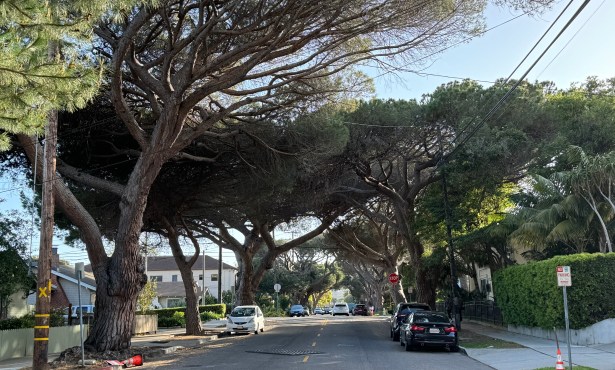Pride Without Prejudice
Dramatic Reversals
LA CONCHITA: After I wrote of Carpinteria’s shameful era of school segregation (1920-1947), I heard of the totally integrated one-room schoolhouse in La Conchita, four miles away in Ventura County.
Anglo, Latino, Filipino, and Pacific Islander kids, children of poor farmers, oil roughnecks, ranch workers, and railroad track crews went to little Punta Gorda School in the 1930s and 1940s, studying, living, and playing together in harmony on the Rincon, according to local historian Bonnie Kelm.

Kelm, herself a La Conchita resident, credits a farsighted philanthropist-rancher, Robert W. Bates, with putting his money where his heart was.
“He believed [in] integration and beyond that, he put money into this poor school for the children of blue-collar workers so that they would have a multicultural education, unheard of in such a public elementary school during the 1930s,” Kelm told me.
The story is told in her cowritten book Greater Carpinteria, Summerland and La Conchita and the current exhibit at the Carpinteria Valley Museum of History. Perhaps Bates “was embarrassed by Carpinteria’s school segregation,” as Kelm told me. Beyond helping finance the school, he helped La Conchita become a “very multicultural community,” she said. It was “kind of a multi-ethnic utopia from the 1930s through the 1950s. International pageants were held, there were field trips to cultural institutions, and the level of academic standards was impressive.
“So many of my informants told me they never knew what prejudice was until they left La Conchita,” said Helm. “The story of the Punta Gorda School and its multicultural program, I believe, is truly unique in the history of California public education at a time when there was a great deal of segregation both blatant and subtle going on throughout the state.”
Bates not only paid for school supplies and other needs but took kids on an overnight visit to the 1939 World’s Fair in San Francisco. Chet Dacayana recounted that his brother Bobby was born without a palate and “would not be able to talk if it had not been for Mrs. Hughes (Margaret Hughes, one of the mothers) and R. W. Bates, who arranged Bob’s surgery at the Shrine Hospital in San Francisco … .” Bates also encouraged the families, some working leased land, to buy lots.
Little Punta Gorda School spawned many success stories, including the Dacayana family, according to Kelm. Chet graduated from Cal Poly and retired in 1992 as district operations manager for Ventura Unified School District. Josephine Dacayana Cabugos attended Immaculate Heart College and Queen of Angels Nursing School and served 33 years as an RN at St. Francis Hospital. Robert Dacayana, Chet’s brother, attended Ventura College and managed the famed Plow and Angel lounge at the San Ysidro Ranch for many years, then the Olive Mill Bistro. Benjamin Dacayana became an engineer for Hughes and Honeywell, and helped develop a space satellite exhibited at the Smithsonian Air and Space Museum.
Ventura officials closed Punta Gorda in 1948. Mary Julanne Giles McDonough recalled how her mother, Madeline Giles, then moved her homeless family into the abandoned building. When officials wanted to move it to Ventura a year later, “My mother protested loud and clear, and when moving day came, the workmen arrived to find my mother standing in the driveway with a gun.
“The city did finally move the building but not my mother. She promptly set up house out in the open on top of the blacktop. She made great fun out of marking off rooms, laying down rugs, and setting all furniture in its place.” Madeline would invite “gandy dancers” — itinerant railroad workers — to al fresco Sunday dinners, setting out her best china and silverware on a formal dining table. To repay Madeline, they built her a house on the spot after a flood swept away her tent.
The next time I drive past little La Conchita, I will think of that time of pride without prejudice.
OPUS NO. 1: You don’t have to like chamber music to appreciate Ensemble Theatre’s latest play, Opus, as a highly dramatic night behind the scenes of a famed string quartet. Private lives beget sour notes, tempers snap like broken bow strings, and footlight harmonies evaporate once the players retreat behind the curtain.
LA TRAVIATA: The audience jeered when Giuseppe Verdi staged his new opera, La Traviata, in Venice in 1853. The singer portraying the beautiful courtesan Violetta was too fat and a bit long in the tooth for the audience’s taste. But when Opera Santa Barbara stages it March 4 and 6 at the Granada, Violetta will be played by the young and beautiful (I’ve met her) Rebecca Davis.
SHOPLIFTING: Stan Bernstein, former owner of now-closed Morninglory Music in downtown Santa Barbara, was highly offended at a comment from an ex-Borders general manager in last week’s column that thieves used to steal stuff from Borders and go over to sell it at Morninglory. “The fact is that Morninglory employees knew not to buy any CDs or DVDs that they suspected were stolen. While it would have been impossible to know with 100 percent certainty that everything we bought was sold by its rightful owner, our policy was to not buy stolen property.”



